 LSI (an Avago Technologies company) Syncro CS has been shipping for over a year now as a self-supported kit and integrated cluster-in-a-box (CiB) solutions are rapidly becoming available. Syncro CS essentially brings high-availability (HA) features to directly attached storage (DAS). Historically DAS architecture has been limited to a single server accessing a single JBOD. With Syncro CS, LSI has enabled a more resilient solution as two server nodes can be connected to DAS storage via Syncro CS, enabling failover in the event a server node goes offline. For those who want to build their own, LSI sells Syncro CS in a kit form that’s easy to deploy across existing or new hardware. OEMs are also bringing product to market that leverages Syncro CS via CiB solutions that makes putting a complete solution to work seamless.
LSI (an Avago Technologies company) Syncro CS has been shipping for over a year now as a self-supported kit and integrated cluster-in-a-box (CiB) solutions are rapidly becoming available. Syncro CS essentially brings high-availability (HA) features to directly attached storage (DAS). Historically DAS architecture has been limited to a single server accessing a single JBOD. With Syncro CS, LSI has enabled a more resilient solution as two server nodes can be connected to DAS storage via Syncro CS, enabling failover in the event a server node goes offline. For those who want to build their own, LSI sells Syncro CS in a kit form that’s easy to deploy across existing or new hardware. OEMs are also bringing product to market that leverages Syncro CS via CiB solutions that makes putting a complete solution to work seamless.
LSI (an Avago Technologies company) Syncro CS has been shipping for over a year now as a self-supported kit and integrated cluster-in-a-box (CiB) solutions are rapidly becoming available. Syncro CS essentially brings high-availability (HA) features to directly attached storage (DAS). Historically DAS architecture has been limited to a single server accessing a single JBOD. With Syncro CS, LSI has enabled a more resilient solution as two server nodes can be connected to DAS storage via Syncro CS, enabling failover in the event a server node goes offline. For those who want to build their own, LSI sells Syncro CS in a kit form that’s easy to deploy across existing or new hardware. OEMs are also bringing product to market that leverages Syncro CS via CiB solutions that makes putting a complete solution to work seamless.
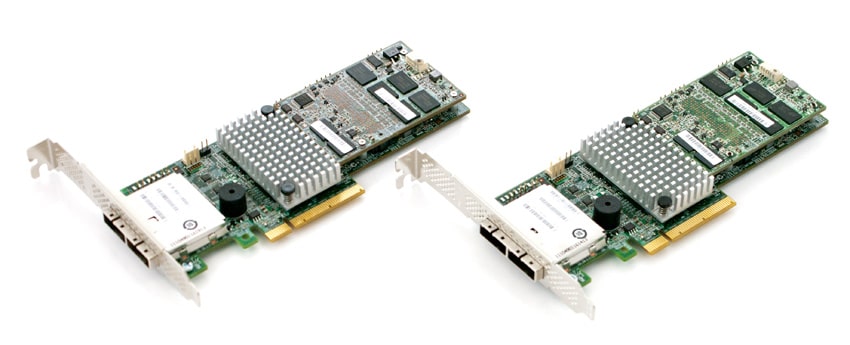
High-availability storage systems are vital for small and medium-sized business (SMBs) who have to have their mission critical systems up and running at all times. Syncro creates an HA-DAS solution so that SMBs have the ability to maintain continuous access to their storage even in the event of a server node failure. Configurations can range from two traditional multiple servers connected to a JBOD or integrated solutions that contain dual server nodes and the storage in a single physical box. At its core, the Syncro solution is clearly about providing small businesses with growing data demands a solution that addresses key resiliency issues like a SAN would, without incurring the cost and complexity that a SAN typically requires.
The LSI Syncro CS 9286-8e and Syncro CS 9271-8i Controllers
LSI currently offers two Syncro CS options, one for external connections and one for internal. The 9286-8e offers affordable high-availability cluster for enterprise continuity from off-the-shelf servers as well as JBOD storage. The 9271-8i transforms storage servers into a compact cluster-in-a-box for high availability, fault-tolerance, and uptime. The 9271-8i enables OEMs and system builders to use Syncro CS controllers to build cost-effective two-node CiB systems and deliver HA in a single self-contained unit.
Syncro CS 9286-8e and Syncro CS 9271-8i specifications:
- RAID Levels: 0, 1, 5, 6, 10, 50, 60
- Drive Support Per Controller: 64 virtual drives (64 total in HA domain)
- LUN Support: Up to 64TB
- Cache Protection: MegaRAID CacheVault flash cache protection (included)
- Controller Operating Voltage: +3.3V, +12V
- RAID & HA Management: MegaRAID Management Suite: MegaRAID Storage Manager, MegaCLI (command-line interface), WebBIOS, SMI-S
- SSD Optimization:
- Up to 32 SSDs (6G SAS) in a CacheCade Read SSD pool
- Up to 64 CacheCade virtual drives (The total # of HDD VD + CacheCade VDs in the HA domain must not exceed 64)
- Up to 512GB CacheCade Read volume capacity in the HA domain
- Host Bus Type: x8 lane PCI Express 3.0
- Devices Supported:
- Up to 96 6G SAS and/or NL-SAS dual-ported HDDs and SSDs (w/SCSI-3 PR)
- Up to 31 6G SAS enclosure/expander devices
- Maximum of 120 dual-ported SAS devices in the HA storage domain.
- External Connectors: 2 Mini-SAS SFF8087
- OS Support: Microsoft Windows Server 2012 and Server 2008 R2, Red Hat Enterprise Linux 6.3 & 6.4, SuSE Linux Enterprise Server 11 SP2 & SP3
- MTBF: 1,251,284 hours
- Operating Temperature: Maximum ambient: Controller Card with included CacheVault module: 55°C
- Regulatory Certifications: EN55022, EN55024, EN60950, EN 61000-3-2, EN 61000-3-3; FCC Class A, Class B; UL1950; UL; CSA C22.2; VCCI; RRL for MIC; BSMI;C-tick; RoHS; WEEE
- Warranty: 3 years, free technical support, advanced replacement option
How Does Syncro Work?
Syncro CS solutions are based on the LSI’s MegaRAID technology and use two controller cards to give system administrators the ability to build a shared DAS solution. Syncro CS increases business uptime, providing uninterrupted continuity and access to the growing data pool of a growing business. It also improves virtualization and mobility between onsite systems and the cloud. At its core, Syncro CS is designed to provide the following protection services:
- The failure of a single internal node does not interrupt service because the solution has multiple nodes with cluster failover.
- An expander failure does not interrupt service because the dual expanders in every enclosure provide redundant data paths.
- A drive failure does not interrupt service because RAID fault tolerance is part of the configuration.
- A system storage expansion or maintenance activity can be completed without requiring an interruption of service because of redundant components, management software, and maintenance procedures.
To leverage these features, we’ve been working with a number of solutions leveraging LSI’s Syncro CS technology, including EchoStream’s DSS320 and Quanta’s MESOS CB220 storage platforms as well as a DIY solution leveraging off the shelf hardware. The common operating system we test across all of these systems is Windows Server 2012 R2, offering an excellent mix of features and performance to drive the most out of each solution. Also included is a seperate Windows Server that runs AD and DNS to manage the clustered aspects of each system and provide failover continuity.
Setup and Management
The setup process to get LSI’s Syncro CS solution up and running is very simple, with the expectation that the JBOD is correctly wired to both servers. If you have an integrated solution this is handled from the factory, but if you are just pairing up two matched servers you should cross reference the manual to get the correct cable routing in place.
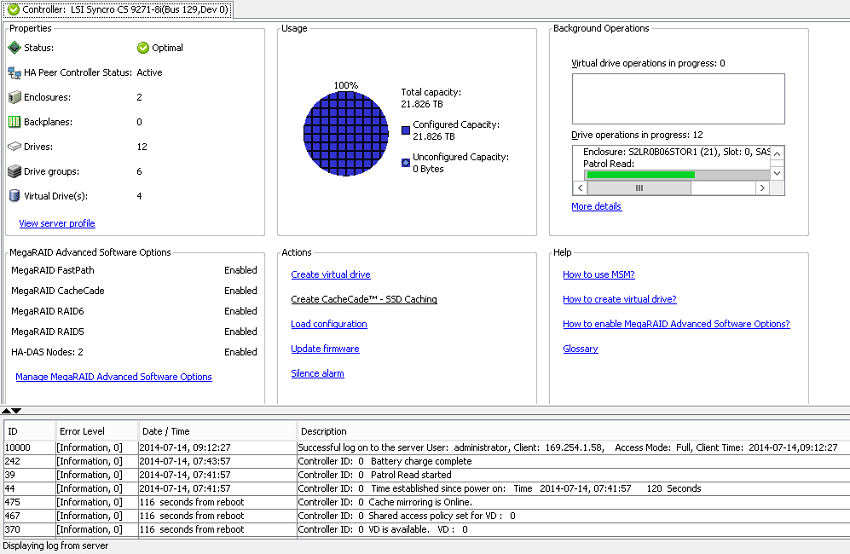
After Windows Server 2012 R2 is installed on each server, with the newest drivers and utilities installed, load the MegaRAID Manager software to create an initial virtual-disk with the storage attached to the server platform. At this stage the physical disks are visible from both systems, although once a virtual disk is created only one server has control over it at a given time. In our environment we created multiple RAID10 volumes across 12 2TB 3.5″ HDDs. These included one volume to act as a witness disk for the Windows cluster, and one volume for each role in our clustered environment. For testing purposes this included one 1TB volume for the SMB/CIFS fileserver and another 1TB volume for the iSCSI Target Server. This process is very similar to the traditional virtual disk creation through the LSI manager, with one exception; the “Provide Shared Access” option. This must be checked for Syncro CS to function.
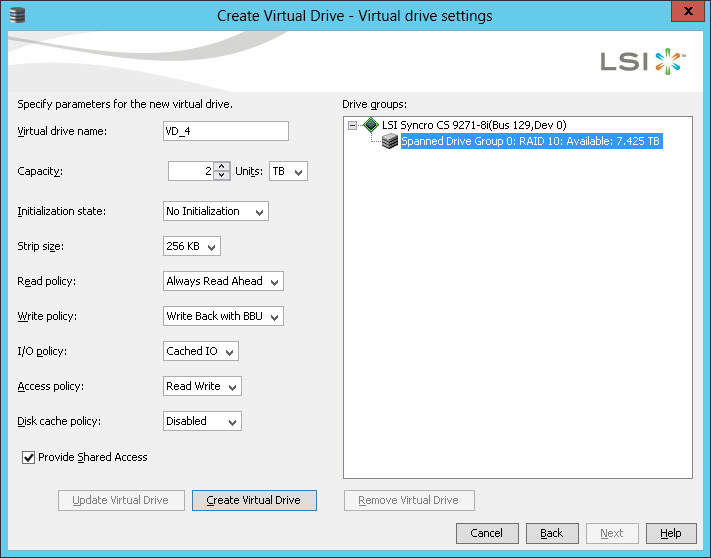
With the volumes created we turned our attention to the Windows Failover Cluster Manager which handles all further management activities inside the Windows Server 2012 environment. From the primary management console you can see the different roles active in the cluster, including our SMB File Server and iSCSI Target Server. From this pane you can also move the service between nodes in the cluster. This is helpful to both verify functionality to simulate a failure, as well as manually balancing the load across your server.
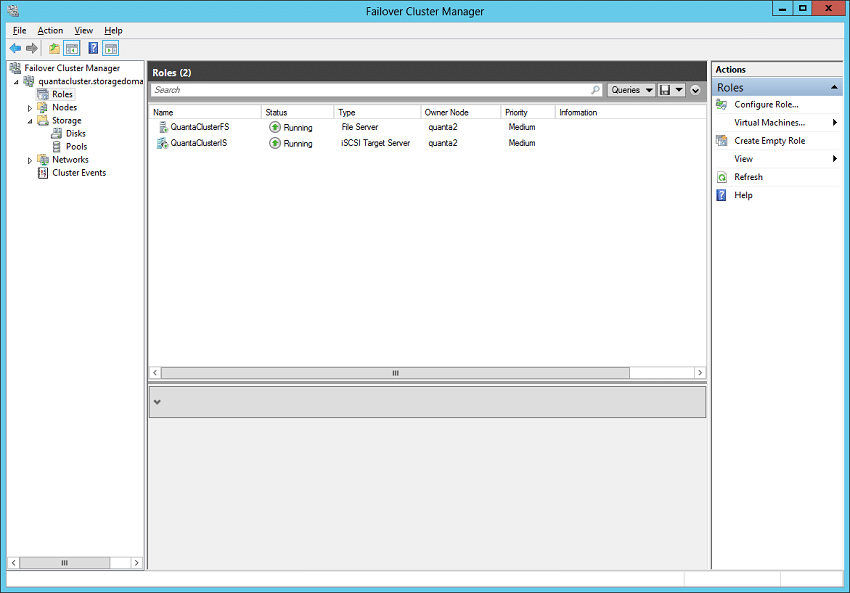
The storage view also allows you to view cluster disks and assign them to new or existing roles.
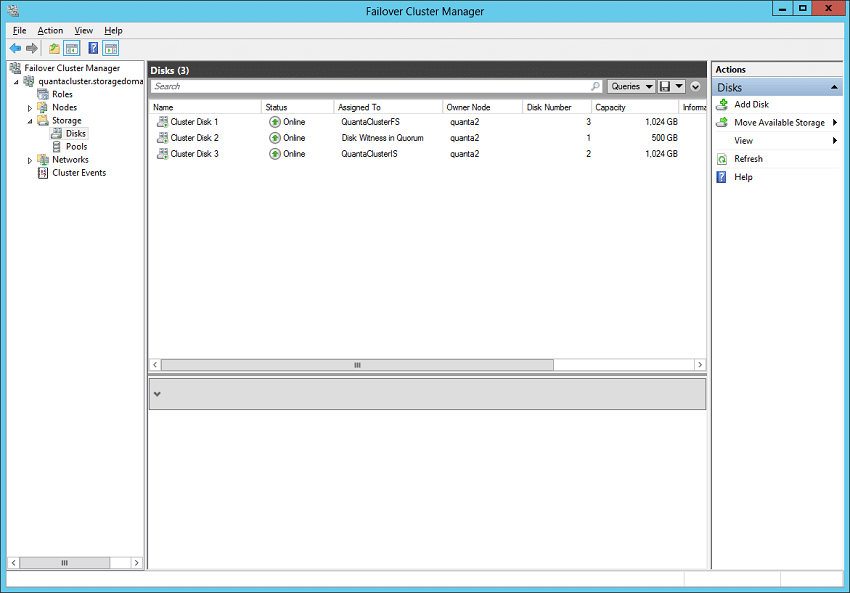
Summary
Syncro CS allows for two nodes to be connected to DAS devices, reducing downtime through its failover features in either Windows or Linux. Syncro comes in two forms, an internal kit that enables CiB vendors to create an all inclusive package with a small footprint (usually 4U or less) and an external kit that offers a more traditional two server to JBOD configuration. Either way, SMBs get SAN-like availability which is critical in the preservation of data access.
LSI’s Syncro can be seen in use by many including products from EchoStreams and Quanta, who utilize Syncro in the consolidation of servers and storage in their clusters, though each takes a slightly different approach to market. SMBs may also deploy Syncro on their own fairly easily, or rely on their MSP or VAR to help in deployment. No matter the configuration or route to deployment, Syncro enables HA DAS storage with a relatively modest investment and little complexity in configuration. For growing businesses that find their reliance on storage availability to be increasingly important, Syncro is an ideal solution.
